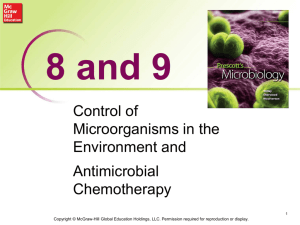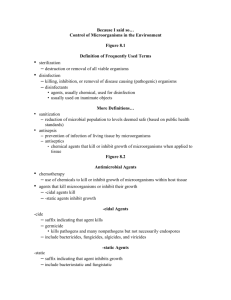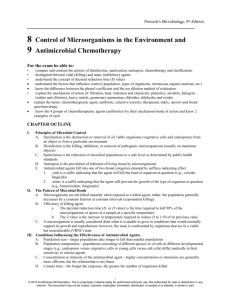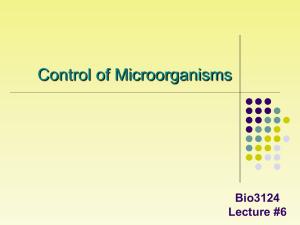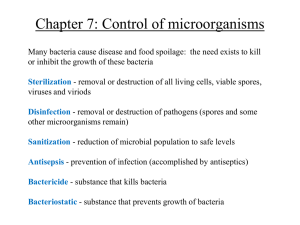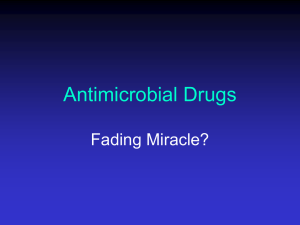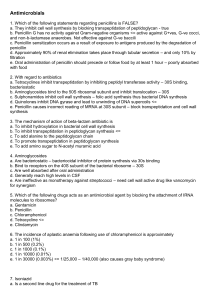PowerPoint
advertisement
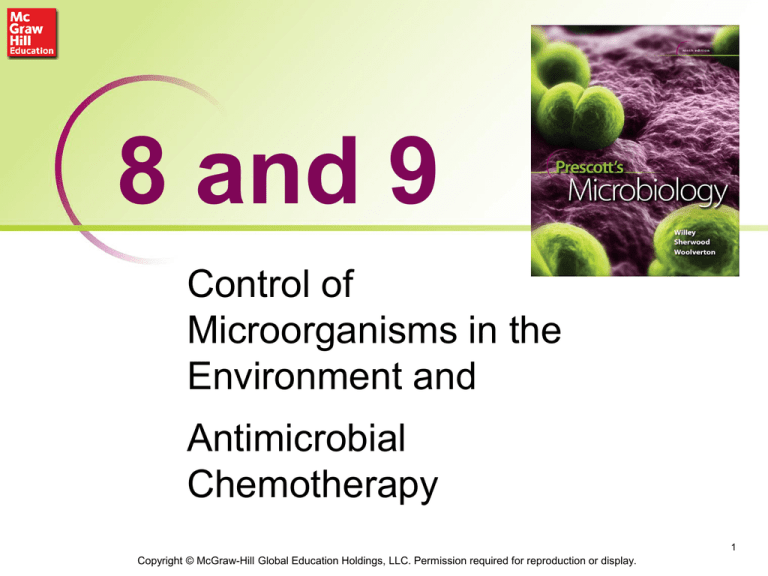
8 and 9 Control of Microorganisms in the Environment and Antimicrobial Chemotherapy 1 Copyright © McGraw-Hill Global Education Holdings, LLC. Permission required for reproduction or display. 2 Definition of Frequently Used Terms • Sterilization – destruction or removal of all viable organisms • Disinfection – killing, inhibition, or removal of disease causing (pathogenic) organisms – disinfectants • agents, usually chemical, used for disinfection • usually used on inanimate objects 3 More Definitions… • Sanitization – reduction of microbial population to levels deemed safe (based on public health standards) • Antisepsis – prevention of infection of living tissue by microorganisms – antiseptics • chemical agents that kill or inhibit growth of microorganisms when applied to tissue 4 Antimicrobial Agents • Chemotherapy – use of chemicals to kill or inhibit growth of microorganisms within host tissue • Agents that kill microorganisms or inhibit their growth – cidal agents kill – static agents inhibit growth 5 -cidal vs. –static Agents -cide – suffix indicating that agent kills – germicide • kills pathogens and many nonpathogens but not necessarily endospores – include bactericides, fungicides, algicides, and viricides -static – suffix indicating that agent inhibits growth – include bacteriostatic and fungistatic 6 The Pattern of Microbial Death • Microorganisms are not killed instantly • Population death usually occurs exponentially • Measure of agent’s killing efficiency – decimal reduction time (D-value) – time to kill 90% – must be sure persister cells (viable but nonculturable (VBNC) condition) are dead • once they recover they may regain the ability to reproduce and cause infection 7 8 9 Conditions Influencing the Effectiveness of Antimicrobial Agent Activity • Population size – larger populations take longer to kill than smaller populations • Population composition – microorganisms differ markedly in their sensitivity to antimicrobial agents 10 More Conditions… • Concentration or intensity of an antimicrobial agent – usually higher concentrations kill more rapidly – relationship is not linear • Duration of exposure longer exposure more organisms killed • Temperature – higher temperatures usually increase killing • Local environment – pH, viscosity, concentration of organic matter, etc. can profoundly impact effectiveness – organisms in biofilms are less susceptible to many antimicrobial agents 11 Filtration • Reduces microbial population or sterilizes solutions of heat-sensitive materials by removing microorganisms • Also used to reduce microbial populations in air 12 Filtering Liquids • Membrane filters – porous membranes with defined pore sizes that remove microorganisms primarily by physical screening 13 Filtering Air • Surgical masks • Cotton plugs on culture vessels • High-efficiency particulate air (HEPA) filters – used in laminar flow biological safety cabinets 14 Physical Control Methods • Heat – – – – – Moist heat Steam: Autoclave Pasteurization Dry heat Incineration • Radiation – Ultraviolet (UV) – Ionizing (gamma) 15 Moist Heat • Destroys viruses, fungi, and bacteria • Boiling will not destroy spores and does not sterilize • Degrades nucleic acids, denatures proteins, and disrupts membranes 16 Steam Sterilization • Carried out above 100oC which requires saturated steam under pressure • Uses an autoclave • Effective against all types of microorganisms (including spores!) • Quality control includes strips with Geobacillus stearothermophilus 17 Pasteurization • Controlled heating at temperatures well below boiling • Used for milk, beer, and other beverages • Process does not sterilize but does kill pathogens present and slow spoilage by reducing the total load of organisms present 18 Dry Heat Sterilization • Less effective than moist heat sterilization, requiring higher temperatures and longer exposure times – items subjected to 160–170oC for 2 to 3 hours • Oxidizes cell constituents and denatures proteins 19 Dry Heat Incineration • Bench top incinerators are used to sterilize inoculating loops used in microbiology laboratories 20 Ultraviolet (UV) Radiation • Wavelength of 260 is most bactericidal (DNA absorbs) • Causes thymine dimers preventing replication and transcription • UV limited to surface sterilization because it does not penetrate glass, dirt films, water, and other substances • Has been used for water treatment 21 Ionizing Radiation • Gamma radiation penetrates deep into objects and forms reactive high energy radicals which are destructive to the DNA and proteins. • Destroys bacterial endospores; not always effective against viruses • Used for sterilization and pasteurization of antibiotics, hormones, sutures, plastic disposable supplies, and food 22 Chemical Control Agents • Disinfection • Antisepsis • Sterilization 23 Chemical Agents should be • Effective against wide variety of infectious agents • Selectively toxic • Effective at low concentrations • Effective in the presence of organic matter • stable in storage • homogeneous Overuse of antiseptics such as triclosan has selected for triclosan resistant bacteria and possibly antibiotic resistant 24 25 26 Phenolics • Commonly used as laboratory and hospital disinfectants • Act by denaturing proteins and disrupting cell membranes • Tuberculocidal, effective in presence of organic material, and long lasting • Disagreeable odor and can cause skin irritation 27 Alcohols • Among the most widely used disinfectants and antiseptics • Two most common are ethanol and isopropanol • Bactericidal, fungicidal, but not sporicidal • Inactivate some viruses • Denature proteins and possibly dissolve membrane lipids 28 Halogens • Any of five elements: fluorine, chlorine, bromine, iodine, and astatine • Important antimicrobial agents 29 Halogens - Iodine • Skin antiseptic • Oxidizes cell constituents and iodinates proteins • At high concentrations may kill spores • Skin damage, staining, and allergies can be a problem • Iodophore – iodine complexed with organic carrier – released slowly to minimize skin burns 30 Halogens - Chlorine • Oxidizes cell constituents • Important in disinfection of water supplies and swimming pools, used in dairy and food industries, effective household disinfectant • Destroys vegetative bacteria and fungi, • Chlorine gas is sporicidal • Can react with organic matter to form carcinogenic compounds – THMs (trihalomethanes) 31 Heavy Metals • e.g., ions of mercury, silver, arsenic, zinc, and copper • Effective but usually toxic • Combine with and inactivate proteins; may also precipitate proteins 32 Quaternary Ammonium Compounds • detergents that have antimicrobial activity and are effective disinfectants – amphipathic organic cleansing agents • most likely disrupts cell membrane • cationic detergents are effective disinfectants – kill most bacteria, but not M. tuberculosis or endospores – safe and easy to use, inactivated by hard water and soap 33 Aldehydes • Commonly used agents are formaldehyde and glutaraldehyde • Highly reactive molecules • Sporicidal and can be used as chemical sterilants • Combine with and inactivate nucleic acids and proteins 34 Sterilizing Gases • Used to sterilize heat-sensitive materials • Microbicidal and sporicidal • Ethylene oxide sterilization is carried out in equipment resembling an autoclave • Betapropiolactone and vaporized hydrogen peroxide • Combine with and inactivate DNA and proteins 35 Evaluation of Antimicrobial Agent Effectiveness • Complex process regulated by U.S. federal agencies – Environmental Protection Agency – Food and Drug Administration 36 Phenol Coefficient Test • Potency of a disinfectant is compared to that of phenol • Useful for screening but may be misleading – Phenol has a residual effectiveness – Protocol involves adding disinfectant and organism to the same tube which is different than how disinfectants are really used 37 Other Evaluation Methods • Use dilution test – determines rate at which selected bacteria are destroyed by various chemical agents – Protocol involves contaminating a bead and then disinfecting • Normal in-use testing – testing done using conditions that approximate normal use of disinfectant 38 Biological Control of Microorganisms • Emerging field showing great promise • Natural control mechanisms – predation by Bdellovibrio – viral-mediated lysis using pathogen specific bacteriophage, currently limited use in food industry but expanded – toxin-mediated killing using bacteriocins 39 Chemotherapeutic Agents • Chemical agents used to treat disease • Destroy pathogenic microbes or inhibit their growth within host • Most are antibiotics – microbial products or their derivatives that kill susceptible microbes or inhibit their growth 40 The Development of Chemotherapy • Paul Ehrlich (1904) – developed concept of selective toxicity – identified dyes that effectively treated African sleeping sickness • Sahachiro Hato (1910) – working with Ehrlich, identified arsenic compounds that effectively treated syphilis • Gerhard Domagk, and Jacques and Therese Trefouel (1935) – discovered sulfonamides and sulfa drugs 41 Penicillin • First discovered by Ernest Duchesne (1896), but discovery lost • Accidentally discovered by Alexander Fleming (1928) – observed penicillin activity on contaminated plate – did not think could be developed further • Effectiveness demonstrated by Florey, Chain, and Heatley (1939) • Fleming, Florey, and Chain received Nobel Prize in 1945 for discovery and production of penicillin 42 43 Later Discoveries • Streptomycin, an antibiotic active against tuberculosis, was discovered by Selman Waksman (1944) – Nobel Prize was awarded to Waksman in 1952 for this discovery • By 1953 chloramphenicol, terramycin, neomycin, and tetracycline isolated 44 General Characteristics of Antimicrobial Drugs • Selective toxicity – ability of drug to kill or inhibit pathogen while damaging host as little as possible • Therapeutic dose – drug level required for clinical treatment • Toxic dose – drug level at which drug becomes too toxic for patient (i.e., produces side effects) • Therapeutic index (high TI is best) – ratio of toxic dose to therapeutic dose – Minimum toxic dose to the host/minimum effective microbial lethal dose 45 General Characteristics of Antimicrobial Drugs… • Side effects – undesirable effects of drugs on host cells • Narrow-spectrum drugs – attack only a few different pathogens • Broad-spectrum drugs – attack many different pathogens • Cidal agent - kills microbes • Static agent - inhibits growth of microbes 46 47 48 General Characteristics of Antimicrobial Drugs… • Effect of an agent may vary – with concentration, microbe, host • Effectiveness expressed in two ways – minimal inhibitory concentration (MIC) • lowest concentration of drug that inhibits growth of pathogen – minimal lethal concentration (MLC) • lowest concentration of drug that kills pathogen 49 Kirby-Bauer Method • Standardized method for disk diffusion test • Sensitivity/resistance determined using tables relating zone diameter with microbial resistance • Table values plotted, used to determine if effective concentration of drug in body can be reached 50 The E Test • Convenient for use with anaerobic pathogens • Similar to disk diffusion method, but uses strip rather than disk • E-test strips contain a gradient of an antibiotic • Intersection of elliptical zone of inhibition with strip indicates MIC 51 Antimicrobial Drugs Classified By Their Mode of Action: 1. Inhibitors of cell wall synthesis 2. Protein synthesis inhibitors 3. Metabolic antagonists 4. Nucleic acid synthesis inhibition 52 1. Inhibitors of Cell Wall Synthesis • Penicillins – most are 6-aminopenicillanic acid derivatives and differ in side chain attached to amino group – most crucial feature of molecule is the blactam ring • essential for bioactivity • many penicillin resistant organisms produce blactamase (penicillinase) which hydrolyzes a bond in this ring 53 Penicillins… • Mode of action – blocks the enzyme that catalyzes transpeptidation (formation of cross-links in peptidoglycan) – prevents the synthesis of complete cell walls leading to lysis of cell – acts only on growing bacteria that are synthesizing new peptidoglycan 54 Other Actions of Penicillins • Binds to periplasmic proteins (penicillinbinding proteins, PBPs) • May activate bacterial autolysins and murein hydrolases • Stimulate bacterial holins to form holes or lesions in the plasma membrane 55 Penicillins… • Naturally occurring penicillins – penicillin V and G are narrow spectrum • Semisynthetic penicillins have a broader spectrum than naturally occurring ones • Resistance to penicillins, including the semisynthetic analogs, continues to be a problem • ~1–5% of adults in U.S. are allergic to penicillin – allergy can lead to a violent allergic response and death 56 Cephalosporins • Structurally and functionally similar to penicillins • Broad-spectrum antibiotics that can be used by most patients that are allergic to penicillin • Four categories based on their spectrum of activity 57 Vancomycin and Teicoplanin • Glycopeptide antibiotics • Inhibit cell wall synthesis • Vancomycin - important for treatment of antibioticresistant staphylococcal and enterococcal infections – previously considered “drug of last resort” so rise in resistance to vancomycin is of great concern 58 2. Protein Synthesis Inhibitors • Many antibiotics bind specifically to the bacterial ribosome – binding can be to 30S (small) or 50S (large) ribosomal subunit • Other antibiotics inhibit a step in protein synthesis – – – – aminoacyl-tRNA binding peptide bond formation mRNA reading translocation 59 Aminoglycoside Antibiotics • Large group, all with a cyclohexane ring, amino sugars • Neomycin, gentamicin, streptomycin, tobramycin • Bind to 30S ribosomal subunit, interfere with protein synthesis by directly inhibiting the process and by causing misreading of the messenger RNA • Resistance and toxicity 60 Tetracyclines • All have a four-ring structure to which a variety of side chains are attached • Are broad spectrum, bacteriostatic • Combine with 30S ribosomal subunit – inhibits bind of aminoacyl-tRNA molecules to the A site of the ribosome • Sometimes used to treat acne 61 Macrolides • Contain 12- to 22-carbon lactone rings linked to one or more sugars • e.g., erythromycin – broad spectrum, usually bacteriostatic – binds to 23S rRNA of 50S ribosomal subunit • inhibits peptide chain elongation • Used for patients allergic to penicillin 62 Chloramphenicol • Now is chemically synthesized • Binds to 23s rRNA on 50S ribosomal subunit and inhibits peptidyl transferase reaction • Toxic with numerous side effects so only used in life-threatening situations 63 3. Metabolic Antagonists • Act as antimetabolites – antagonize or block functioning of metabolic pathways by competitively inhibiting the use of metabolites by key enzymes • Are structural analogs – molecules that are structurally similar to, and compete with, naturally occurring metabolic intermediates • block normal cellular metabolism 64 Sulfonamides or Sulfa Drugs • Structurally related to sulfanilamide, a paminobenzoic acid (PABA) analog • PABA used for the synthesis of folic acid and is made by many pathogens – sulfa drugs are selectively toxic due to competitive inhibition of folic acid synthesis enzymes 65 Trimethoprim • Synthetic antibiotic that also interferes with folic acid production • Broad spectrum • Can be combined with sulfa drugs to increase efficacy of treatment: Bactrim or Septra – combination blocks two steps in folic acid pathway • Has a variety of side effects including abdominal pain and photosensitivity reactions 66 Nucleic Acid Synthesis Inhibition • A variety of mechanisms – block DNA replication • inhibition of DNA polymerase • inhibition of DNA helicase – block transcription • inhibition of RNA polymerase • Drugs not as selectively toxic as other antibiotics because bacteria and eukaryotes do not differ greatly in the way they synthesize nucleic acids 67 Quinolones • Broad-spectrum, synthetic drugs containing the 4quinolone ring: Cipro (ciprofloxacin) and Levaquin • Nalidixic acid first synthesized quinolone (1962) • Act by inhibiting bacterial DNA-gyrase and topoisomerase II • Broad spectrum, bactericidal, wide range of infections 68 Factors Influencing Antimicrobial Drugs • Ability of drug to reach site of infection • Susceptibility of pathogen to drug • Ability of drug to reach concentrations in body that exceed MIC of pathogen 69 Ability of Drug to Reach Site of Infection • Depends in part on mode of administration – oral • some drugs destroyed by stomach acid – topical – parenteral routes • nonoral routes of administration • Drug can be excluded by blood clots or necrotic tissue 70 Factors Influencing Ability of Drug to Reach Concentrations Exceeding MIC • Amount administered • Route of administration • Speed of uptake • Rate of clearance (elimination) from body 71 Drug Resistance • An increasing problem – once resistance originates in a population it can be transmitted to other bacteria – a particular type of resistance mechanism is not confirmed to a single class of drugs • Microbes in abscesses or biofilms may be growing slowly and not be susceptible • Resistance mutants arise spontaneously and are then selected 72 Overcoming Drug Resistance • Give drug in appropriate concentrations to destroy susceptible • Give two or more drugs at same time • Use drugs only when necessary • Possible future solutions – continued development of new drugs – use of bacteriophages to treat bacterial disease 73
